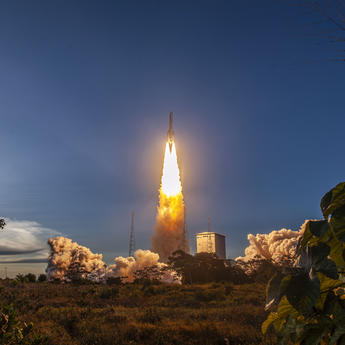Images can be haunting. Corrugated roofs lying twisted on the rubble of homes they sheltered. People dotted like colorful pins in the grey debris where once stood a school or market.
The human tragedy of the magnitude-7.2 earthquake that rocked Haiti on 14 August is still ongoing. Its devastation was made worse by the passage of Tropical Storm Grace, which added landslides and flooding to the “perfect storm” of political instability, social hardship, and food insecurity facing the country.

Relief for a population in need
An international disaster response was on the scene from the first days after the quake. Coordinating the aerial arm of this effort for the United States was the Department of Defense U.S. Southern Command (SOUTHCOM), which called on assets from the Puerto Rico National Guard. Their team of 22 military reservists and three helicopters – among them a UH-72 Lakota – departed on 17 August and remained three weeks.
They were sorely needed. The first line of response was to search for and rescue injured Haitians, as well as transport some 70 members of disaster assistance response teams. In all, they carried out nine medical evacuations and delivered more than 17,300 pounds (7.7 kg) of supplies, food and shelter.
A pilot, co-pilot and crew chief typically made up the crew on board. The pilot in command is a full-time National Guardsman with vast flight experience. Equally experienced although part-time with the National Guard, the co-pilot and crew chief may have different backgrounds that nevertheless involve flying search and rescue and ISR. Many hold jobs in counter-narcotics, U.S. Customs, U.S. border patrol or the U.S. Coast Guard—experience that served well in the earthquake’s aftermath.

Unique capabilities
Within days, another issue became apparent—the necessity for an informed view of the scale of the destruction. Col. Samuel Agosto, Task Force Puerto Rico-Haiti Commander, recalls the need from aid agencies to survey available routes, bridges and runways—information that was critical for building field hospitals, for instance, which require flying in large resources like generators and water purification systems. “To bring those assets to the area, we needed to understand if the runway was capable,” says Col. Agosto.
“The Lakota was unique among the airframes there,” the colonel says. “It drew a lot of attention from the commander asking what its capability could bring. We explained it had a video camera and could be used for intelligence, surveillance, reconnaissance [ISR] missions.” With the Joint Task Force’s need to understand the environment, “the Lakota became vital. Its ISR helped in analysis and future planning,” Col. Agosto adds.
The Puerto Rico National Guard carried out 26 aerial surveys and the Lakota’s ISR gathering ultimately allowed more than 700,000 pounds (317 kg) of international aid to reach communities in Jérémie, Les Cayes, Miragoâne, Petit Trou de Nippes and Maniche, among others.

The point of need
“We tried to get to the point of need. As people displace after something happens, we started to see that from the air we could identify where people were moving to. We were operating in support of the USAID*,” says the colonel. “Every day in the morning we’d sit down with the USAID and learn where we needed to transport goods. I’d turn around and task my pilots and we’d put together a maintenance plan around which assets I had on that particular day. We had a good plan to address the coming days and to ensure safety.”
“There was a lot of international engagement, a lot of synchronisation,” says Col. Agosto. “Our folks there did a great job.”
*USAID: U.S. Agency for International Development
Latest News
Continue Reading

Airbus ships fourth European Service Module for Artemis IV
Press Release
Space
Fourth European Service Module (ESM-4) is ready to leave Airbus’ facilities in Bremen, Germany, and be shipped to NASA’s Kennedy Space Center, Florida, USA
Sentinel-1D: the radar that never sleeps
Web Story
Space

Airbus-built SpainSat NG-II secure communications satellite successfully launched
Press Release
Space

Airbus, Leonardo and Thales sign Memorandum of Understanding to create a leading…
Press Release
Company

Tracking air pollution from space
Web Story
Space
